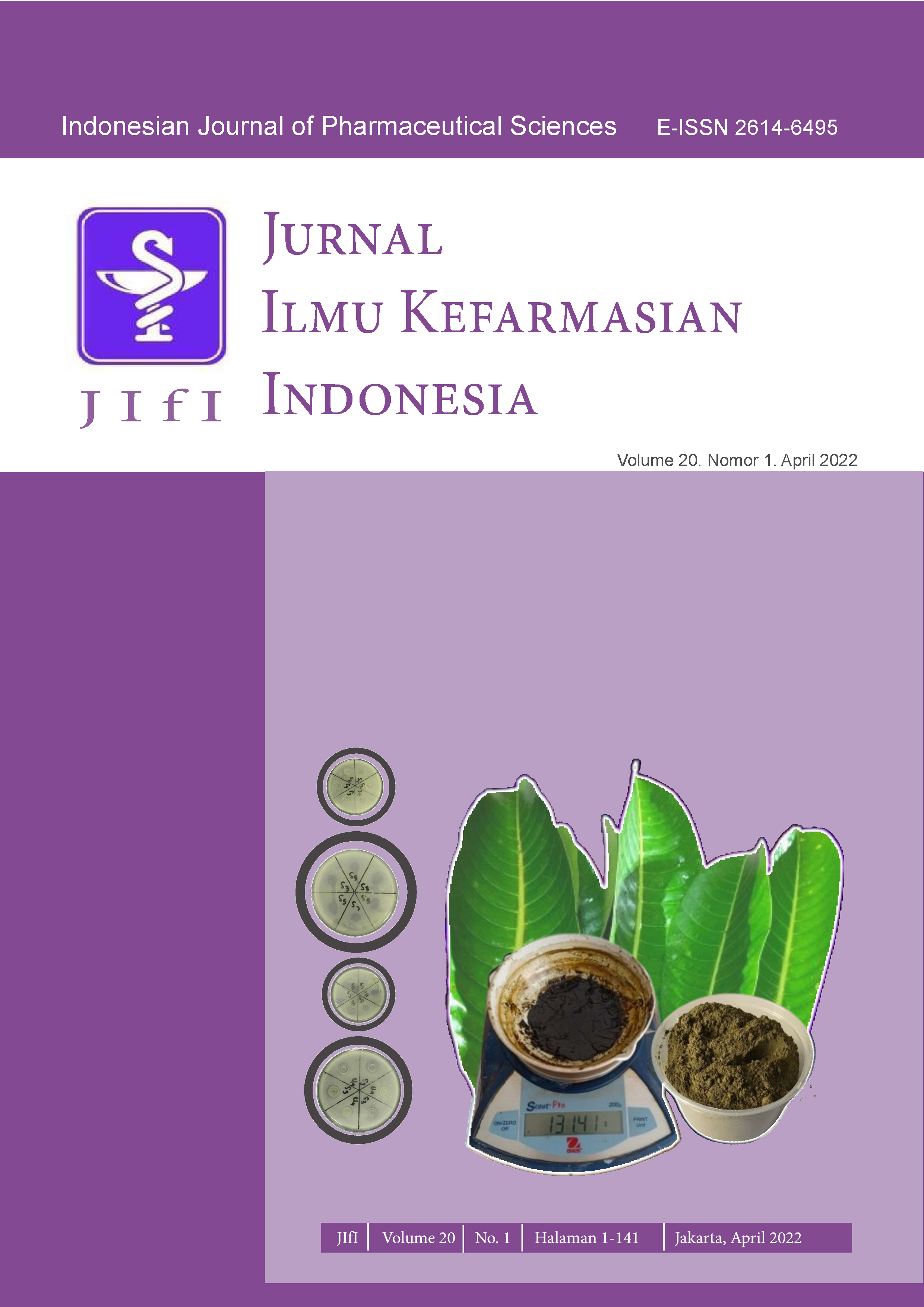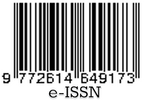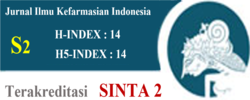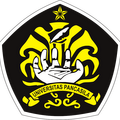Antioxidant Activity Of Peel-Off Mask Containing Coffee (Coffea arabica) and Turmeric (Curcuma longa) Using DPPH Method
Abstract
Peel-Off face mask is one of the cosmetics that is used to treat skin from free radicals. Coffee (Coffea arabica) contains chlorogenic, ferulic, caffeic, and n-coumaric acids which can be useful as antioxidants. Turmeric (Curcuma longa) contains curcumin, which has anti-inflammatory and antioxidant properties. The purpose of this study is to evaluate the quality parameters and analyzed the antioxidant activity of peel-off masks containing coffee (Coffea arabica) and turmeric (Curcuma longa). This research has made 3 mask formulas, each of which contains coffee and turmeric. The formula made was a combination of coffee and turmeric with a ratio of each formula F1 (10:0), F2 (5:,5) and F3 (0:10). The result of organoleptic parameters for F1 was dark brown with coffee aroma and consistency like gel, F2 wasyellowish-brownn with spiced coffee aroma and consistency like gel and F3 was yellow with turmeric aroma and consistency like gel. The result of the homogeneity test of all formulasmula was homogeny. The result of the pH value of all formulasmula was 5. The resulspreadabilityd ability of F1, F2 and F3 were 26.877 cm2; 26.278 cm2; 26.875 cm2. The drying time of each formula was F1 27.36 min; F2 28.38 min; F3 28.54 min. The antioxidant activity is shown the by IC50 value. The value of IC50 for each formula F1 (37.277 ppm), F2 (34.757 ppm), and F3 (37.399 ppm). The test results showed that all formulas met the quality test requirements and had very strong antioxidant activity.
References
2. Sumiyati, Mandike G. Peel-off Gel Mask Formulation from Kepok Banana Peel (Musa paradisiaca L.). Jurnal Dunia Farmasi. 2017;1(3):123–33.
3. Anindita AH, Masluhiya S. Natural mask formulation made from seaweed and chocolate reduces wrinkles and blemishes on facial skin. Jurnal Care. 2017;5(2):393–402.
4. Sharma H. A Detail Chemistry of Coffee and Its Analysis. IntechOpen: Nepal.2020.
5. Yashin A, Yashin Y, Wang JY, Nemzer B. Antioxidant and Antiradical Activity of Coffee. Antioxidants. 2013:2(1):230-45.
6. Kumar A, Singh M, Singh PP, Singh SK, Raj P, Pandey KD. Antioxidant Efficacy and Curcumin Content of Turmeric (Curcuma longa L.) Flower. International Journal of Current Pharmaceutical Research. 2016:8(3):112-14.
7. Beringhts AOR, Stulzer HK, Rosa J, Budal RM. Green Clay, and Aloe Vera Peel-Off Facial Mas : Response Surface Methodology Applied to the Formulation Design. AAPS PharmSciTech. 2013:14(1):445-55.
8. Jani TA, Hakim A, Juliantoni Y. Formulation and Evaluation of Antioxidant Peel-off Face Mask Containing Red Dragon Fruit Rind Extract (Hylocereus polyrhizus Haw). Jurnal Biologi Tropis. 2020:20(3):438-45.
9. Rum IA, Suherman HW, Idar. Formulation and evaluation of peel-off mask gel mask from whole milk yogurt and seaweed (Eucheuma cottonii) as antioxidant sources. Pharm Pharmacol Int J. 2021;9(4):132-35.
10. Rowe, Raymond C, Sheskey PJ, Quinn ME. Handbook of Pharmaceutical Excipients. Sixth Edition. Chicago London: Pharmaceutical Press.
11. Salusu HD, Ariani F, Obeth E, Rayment M, Budiarso E, Kusuma IW, Arung ET. Phytochemical Screening and Antioxidant Activity of Selekop (Lepisanthes amoena) Fruit. AGRIVITA Journal of Agricultural Science. 2017:39(2):214-18.
12. Hartati H, Husain F, Slamet NS, Mohamad F, Sapiun Z. Uji Aktivitas Antioksidan Sediaan Lip Balm Rambut Jagung (Zea mays L.) dengan Metode DPPH (1, 1-Diphenyl-2-Picrylhydrazyl). JURNAL ILMU KEFARMASIAN INDONESIA. 2020 Oct 28;18(2):220-6.
13. Badarinath AV, Rao KM, Chetty CM, Ramkanth ST, Rajan TV, Gnanaprakash K. A review on in-vitro antioxidant methods: comparisions, correlations and considerations. International Journal of PharmTech Research. 2010 Jan 1;2(2):1276-85.
14. Pratami DK, Desmiaty Y, Simorangkir EM, Faradhila D. Standardisasi dan Uji Aktivitas Antioksidan Ekstrak Bahan Alam Propolis untuk Terapi Infeksi SARS-CoV2. JURNAL ILMU KEFARMASIAN INDONESIA. 2021 Dec 31;19(2):272-80.
15. Farida S, Pratami DK, Sahlan M, Laksmitawati DR, Rohmatin E, Situmorang H. In-vitro antioxidant, in-vivo anti-inflammatory, and acute toxicity study of Indonesian propolis capsule from Tetragonula sapiens. Saudi Journal of Biological Sciences. 2022 Apr 1;29(4):2489-500.

This work is licensed under a Creative Commons Attribution-NonCommercial-ShareAlike 4.0 International License.
Licencing
All articles in Jurnal Ilmu Kefarmasian Indonesia are an open-access article, distributed under the terms of the Creative Commons Attribution-NonCommercial-ShareAlike 4.0 International License which permits unrestricted non-commercial used, distribution and reproduction in any medium.
This licence applies to Author(s) and Public Reader means that the users mays :
- SHARE:
copy and redistribute the article in any medium or format - ADAPT:
remix, transform, and build upon the article (eg.: to produce a new research work and, possibly, a new publication) - ALIKE:
If you remix, transform, or build upon the article, you must distribute your contributions under the same license as the original. - NO ADDITIONAL RESTRICTIONS:
You may not apply legal terms or technological measures that legally restrict others from doing anything the license permits.
It does however mean that when you use it you must:
- ATTRIBUTION: You must give appropriate credit to both the Author(s) and the journal, provide a link to the license, and indicate if changes were made. You may do so in any reasonable manner, but not in any way that suggests the licensor endorses you or your use.
You may not:
- NONCOMMERCIAL: You may not use the article for commercial purposes.
This work is licensed under a Creative Commons Attribution-NonCommercial-ShareAlike 4.0 International License.





 Tools
Tools





















